UNCC300 Essay: Fast Food's Impact on Global Health and Society
VerifiedAdded on 2022/12/26
|5
|1506
|46
Essay
AI Summary
This essay critically examines the global issue of the fast-food market and its adverse impacts on health and society, focusing on the principle of the common good. It analyzes the increasing rates of obesity and mortality linked to fast food consumption and the lack of effective strategies to mitigate these consequences. The essay proposes various solutions, including government involvement, societal awareness campaigns, and initiatives from food providers and agencies. It emphasizes the importance of education, alternative food options, and policy changes to address the challenges posed by fast food and promote a healthier global community. The essay draws on principles of human advocacy, dignity, and community engagement to suggest actionable steps for realizing the common good in a global context, and offers a comprehensive overview of the health challenges associated with fast food.
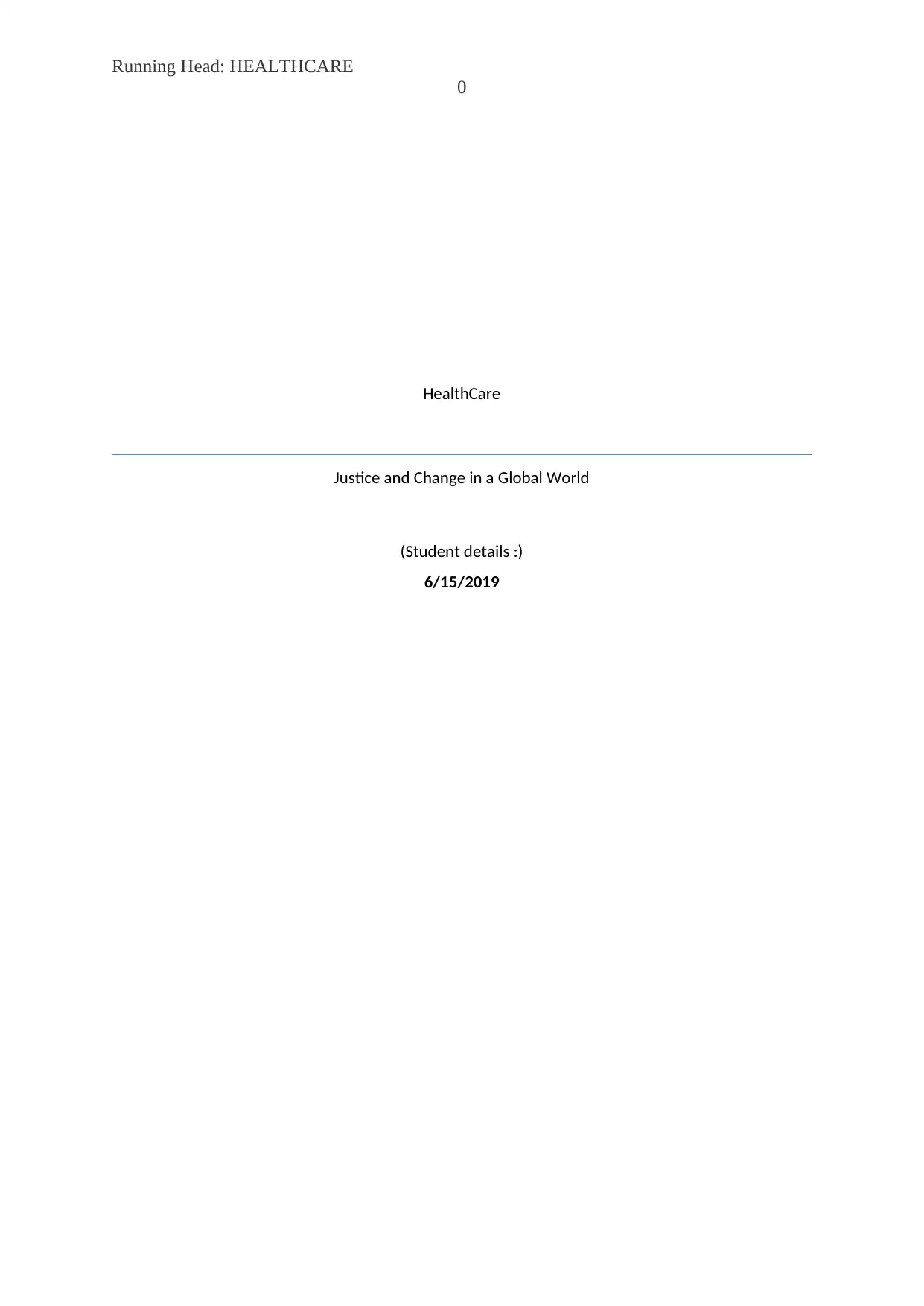
Running Head: HEALTHCARE
0
HealthCare
Justice and Change in a Global World
(Student details :)
6/15/2019
0
HealthCare
Justice and Change in a Global World
(Student details :)
6/15/2019
Paraphrase This Document
Need a fresh take? Get an instant paraphrase of this document with our AI Paraphraser
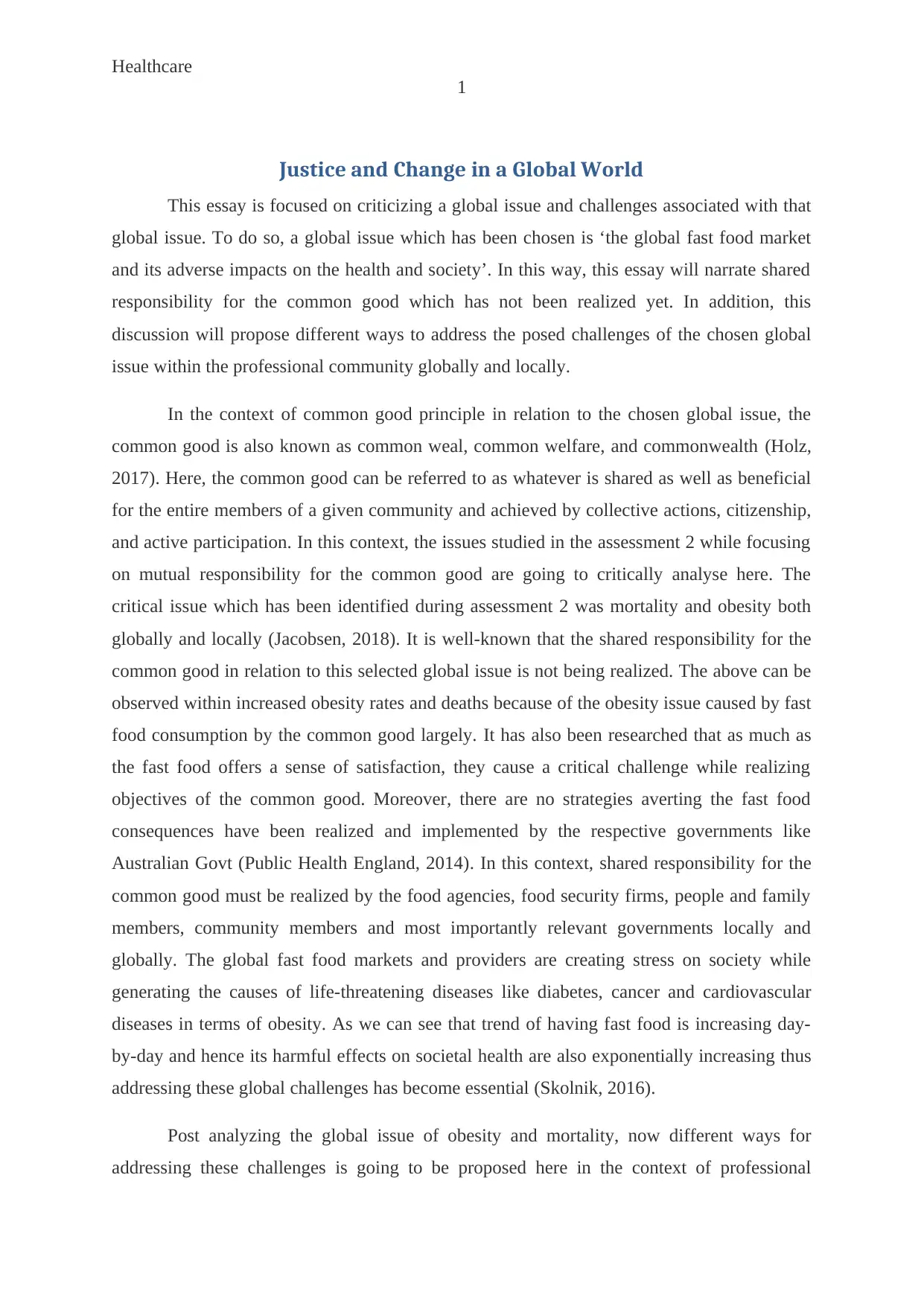
Healthcare
1
Justice and Change in a Global World
This essay is focused on criticizing a global issue and challenges associated with that
global issue. To do so, a global issue which has been chosen is ‘the global fast food market
and its adverse impacts on the health and society’. In this way, this essay will narrate shared
responsibility for the common good which has not been realized yet. In addition, this
discussion will propose different ways to address the posed challenges of the chosen global
issue within the professional community globally and locally.
In the context of common good principle in relation to the chosen global issue, the
common good is also known as common weal, common welfare, and commonwealth (Holz,
2017). Here, the common good can be referred to as whatever is shared as well as beneficial
for the entire members of a given community and achieved by collective actions, citizenship,
and active participation. In this context, the issues studied in the assessment 2 while focusing
on mutual responsibility for the common good are going to critically analyse here. The
critical issue which has been identified during assessment 2 was mortality and obesity both
globally and locally (Jacobsen, 2018). It is well-known that the shared responsibility for the
common good in relation to this selected global issue is not being realized. The above can be
observed within increased obesity rates and deaths because of the obesity issue caused by fast
food consumption by the common good largely. It has also been researched that as much as
the fast food offers a sense of satisfaction, they cause a critical challenge while realizing
objectives of the common good. Moreover, there are no strategies averting the fast food
consequences have been realized and implemented by the respective governments like
Australian Govt (Public Health England, 2014). In this context, shared responsibility for the
common good must be realized by the food agencies, food security firms, people and family
members, community members and most importantly relevant governments locally and
globally. The global fast food markets and providers are creating stress on society while
generating the causes of life-threatening diseases like diabetes, cancer and cardiovascular
diseases in terms of obesity. As we can see that trend of having fast food is increasing day-
by-day and hence its harmful effects on societal health are also exponentially increasing thus
addressing these global challenges has become essential (Skolnik, 2016).
Post analyzing the global issue of obesity and mortality, now different ways for
addressing these challenges is going to be proposed here in the context of professional
1
Justice and Change in a Global World
This essay is focused on criticizing a global issue and challenges associated with that
global issue. To do so, a global issue which has been chosen is ‘the global fast food market
and its adverse impacts on the health and society’. In this way, this essay will narrate shared
responsibility for the common good which has not been realized yet. In addition, this
discussion will propose different ways to address the posed challenges of the chosen global
issue within the professional community globally and locally.
In the context of common good principle in relation to the chosen global issue, the
common good is also known as common weal, common welfare, and commonwealth (Holz,
2017). Here, the common good can be referred to as whatever is shared as well as beneficial
for the entire members of a given community and achieved by collective actions, citizenship,
and active participation. In this context, the issues studied in the assessment 2 while focusing
on mutual responsibility for the common good are going to critically analyse here. The
critical issue which has been identified during assessment 2 was mortality and obesity both
globally and locally (Jacobsen, 2018). It is well-known that the shared responsibility for the
common good in relation to this selected global issue is not being realized. The above can be
observed within increased obesity rates and deaths because of the obesity issue caused by fast
food consumption by the common good largely. It has also been researched that as much as
the fast food offers a sense of satisfaction, they cause a critical challenge while realizing
objectives of the common good. Moreover, there are no strategies averting the fast food
consequences have been realized and implemented by the respective governments like
Australian Govt (Public Health England, 2014). In this context, shared responsibility for the
common good must be realized by the food agencies, food security firms, people and family
members, community members and most importantly relevant governments locally and
globally. The global fast food markets and providers are creating stress on society while
generating the causes of life-threatening diseases like diabetes, cancer and cardiovascular
diseases in terms of obesity. As we can see that trend of having fast food is increasing day-
by-day and hence its harmful effects on societal health are also exponentially increasing thus
addressing these global challenges has become essential (Skolnik, 2016).
Post analyzing the global issue of obesity and mortality, now different ways for
addressing these challenges is going to be proposed here in the context of professional
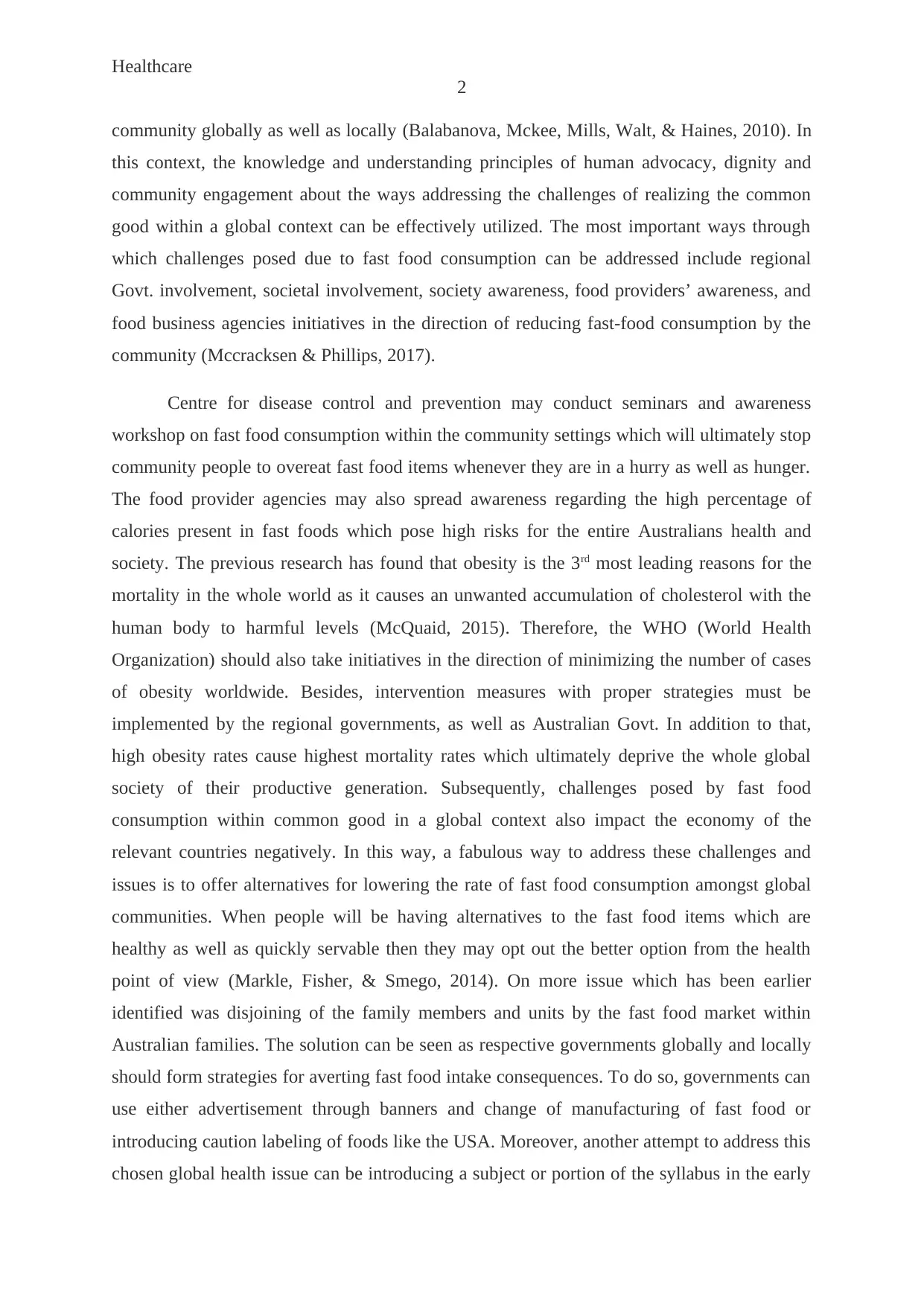
Healthcare
2
community globally as well as locally (Balabanova, Mckee, Mills, Walt, & Haines, 2010). In
this context, the knowledge and understanding principles of human advocacy, dignity and
community engagement about the ways addressing the challenges of realizing the common
good within a global context can be effectively utilized. The most important ways through
which challenges posed due to fast food consumption can be addressed include regional
Govt. involvement, societal involvement, society awareness, food providers’ awareness, and
food business agencies initiatives in the direction of reducing fast-food consumption by the
community (Mccracksen & Phillips, 2017).
Centre for disease control and prevention may conduct seminars and awareness
workshop on fast food consumption within the community settings which will ultimately stop
community people to overeat fast food items whenever they are in a hurry as well as hunger.
The food provider agencies may also spread awareness regarding the high percentage of
calories present in fast foods which pose high risks for the entire Australians health and
society. The previous research has found that obesity is the 3rd most leading reasons for the
mortality in the whole world as it causes an unwanted accumulation of cholesterol with the
human body to harmful levels (McQuaid, 2015). Therefore, the WHO (World Health
Organization) should also take initiatives in the direction of minimizing the number of cases
of obesity worldwide. Besides, intervention measures with proper strategies must be
implemented by the regional governments, as well as Australian Govt. In addition to that,
high obesity rates cause highest mortality rates which ultimately deprive the whole global
society of their productive generation. Subsequently, challenges posed by fast food
consumption within common good in a global context also impact the economy of the
relevant countries negatively. In this way, a fabulous way to address these challenges and
issues is to offer alternatives for lowering the rate of fast food consumption amongst global
communities. When people will be having alternatives to the fast food items which are
healthy as well as quickly servable then they may opt out the better option from the health
point of view (Markle, Fisher, & Smego, 2014). On more issue which has been earlier
identified was disjoining of the family members and units by the fast food market within
Australian families. The solution can be seen as respective governments globally and locally
should form strategies for averting fast food intake consequences. To do so, governments can
use either advertisement through banners and change of manufacturing of fast food or
introducing caution labeling of foods like the USA. Moreover, another attempt to address this
chosen global health issue can be introducing a subject or portion of the syllabus in the early
2
community globally as well as locally (Balabanova, Mckee, Mills, Walt, & Haines, 2010). In
this context, the knowledge and understanding principles of human advocacy, dignity and
community engagement about the ways addressing the challenges of realizing the common
good within a global context can be effectively utilized. The most important ways through
which challenges posed due to fast food consumption can be addressed include regional
Govt. involvement, societal involvement, society awareness, food providers’ awareness, and
food business agencies initiatives in the direction of reducing fast-food consumption by the
community (Mccracksen & Phillips, 2017).
Centre for disease control and prevention may conduct seminars and awareness
workshop on fast food consumption within the community settings which will ultimately stop
community people to overeat fast food items whenever they are in a hurry as well as hunger.
The food provider agencies may also spread awareness regarding the high percentage of
calories present in fast foods which pose high risks for the entire Australians health and
society. The previous research has found that obesity is the 3rd most leading reasons for the
mortality in the whole world as it causes an unwanted accumulation of cholesterol with the
human body to harmful levels (McQuaid, 2015). Therefore, the WHO (World Health
Organization) should also take initiatives in the direction of minimizing the number of cases
of obesity worldwide. Besides, intervention measures with proper strategies must be
implemented by the regional governments, as well as Australian Govt. In addition to that,
high obesity rates cause highest mortality rates which ultimately deprive the whole global
society of their productive generation. Subsequently, challenges posed by fast food
consumption within common good in a global context also impact the economy of the
relevant countries negatively. In this way, a fabulous way to address these challenges and
issues is to offer alternatives for lowering the rate of fast food consumption amongst global
communities. When people will be having alternatives to the fast food items which are
healthy as well as quickly servable then they may opt out the better option from the health
point of view (Markle, Fisher, & Smego, 2014). On more issue which has been earlier
identified was disjoining of the family members and units by the fast food market within
Australian families. The solution can be seen as respective governments globally and locally
should form strategies for averting fast food intake consequences. To do so, governments can
use either advertisement through banners and change of manufacturing of fast food or
introducing caution labeling of foods like the USA. Moreover, another attempt to address this
chosen global health issue can be introducing a subject or portion of the syllabus in the early
⊘ This is a preview!⊘
Do you want full access?
Subscribe today to unlock all pages.

Trusted by 1+ million students worldwide
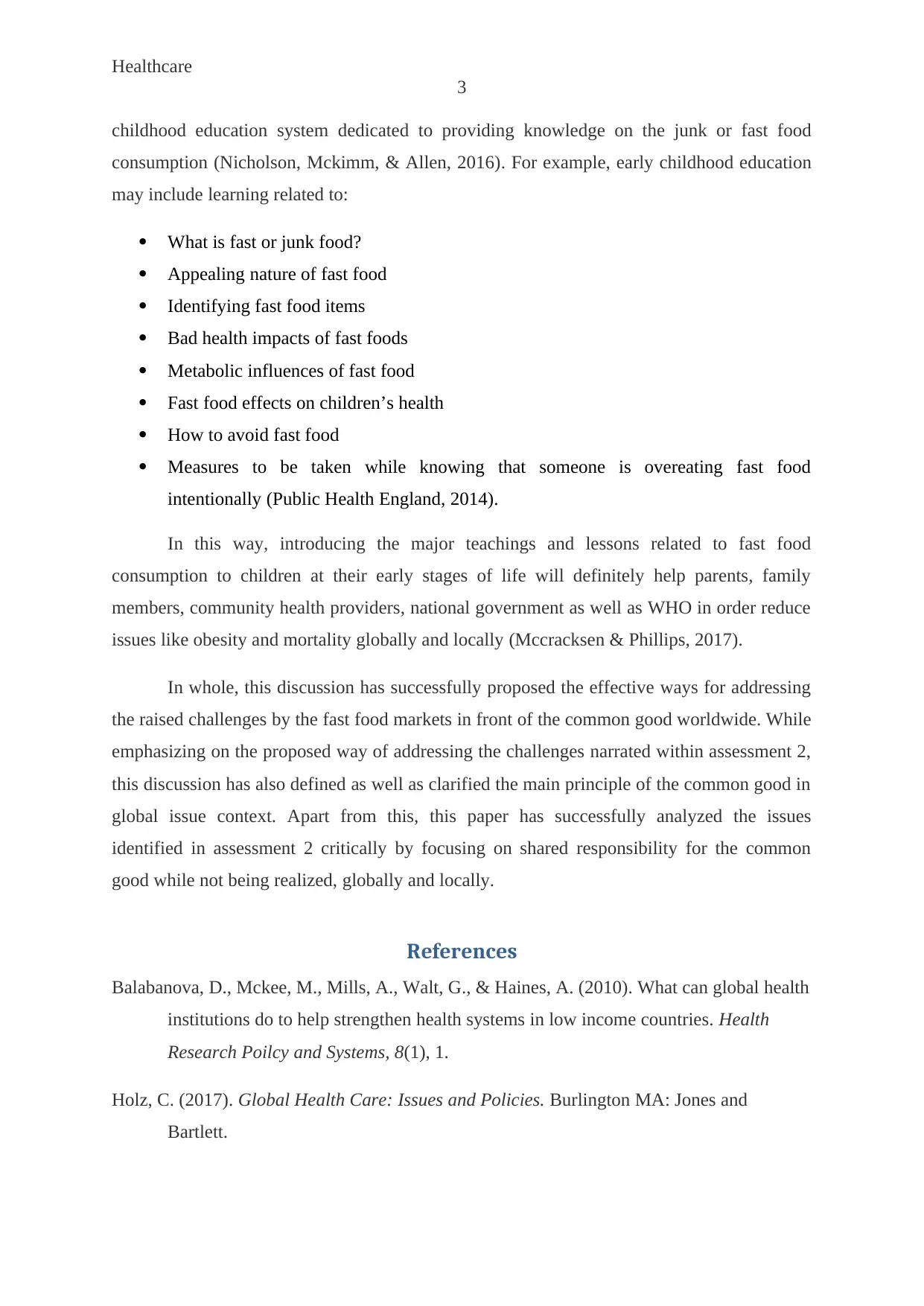
Healthcare
3
childhood education system dedicated to providing knowledge on the junk or fast food
consumption (Nicholson, Mckimm, & Allen, 2016). For example, early childhood education
may include learning related to:
What is fast or junk food?
Appealing nature of fast food
Identifying fast food items
Bad health impacts of fast foods
Metabolic influences of fast food
Fast food effects on children’s health
How to avoid fast food
Measures to be taken while knowing that someone is overeating fast food
intentionally (Public Health England, 2014).
In this way, introducing the major teachings and lessons related to fast food
consumption to children at their early stages of life will definitely help parents, family
members, community health providers, national government as well as WHO in order reduce
issues like obesity and mortality globally and locally (Mccracksen & Phillips, 2017).
In whole, this discussion has successfully proposed the effective ways for addressing
the raised challenges by the fast food markets in front of the common good worldwide. While
emphasizing on the proposed way of addressing the challenges narrated within assessment 2,
this discussion has also defined as well as clarified the main principle of the common good in
global issue context. Apart from this, this paper has successfully analyzed the issues
identified in assessment 2 critically by focusing on shared responsibility for the common
good while not being realized, globally and locally.
References
Balabanova, D., Mckee, M., Mills, A., Walt, G., & Haines, A. (2010). What can global health
institutions do to help strengthen health systems in low income countries. Health
Research Poilcy and Systems, 8(1), 1.
Holz, C. (2017). Global Health Care: Issues and Policies. Burlington MA: Jones and
Bartlett.
3
childhood education system dedicated to providing knowledge on the junk or fast food
consumption (Nicholson, Mckimm, & Allen, 2016). For example, early childhood education
may include learning related to:
What is fast or junk food?
Appealing nature of fast food
Identifying fast food items
Bad health impacts of fast foods
Metabolic influences of fast food
Fast food effects on children’s health
How to avoid fast food
Measures to be taken while knowing that someone is overeating fast food
intentionally (Public Health England, 2014).
In this way, introducing the major teachings and lessons related to fast food
consumption to children at their early stages of life will definitely help parents, family
members, community health providers, national government as well as WHO in order reduce
issues like obesity and mortality globally and locally (Mccracksen & Phillips, 2017).
In whole, this discussion has successfully proposed the effective ways for addressing
the raised challenges by the fast food markets in front of the common good worldwide. While
emphasizing on the proposed way of addressing the challenges narrated within assessment 2,
this discussion has also defined as well as clarified the main principle of the common good in
global issue context. Apart from this, this paper has successfully analyzed the issues
identified in assessment 2 critically by focusing on shared responsibility for the common
good while not being realized, globally and locally.
References
Balabanova, D., Mckee, M., Mills, A., Walt, G., & Haines, A. (2010). What can global health
institutions do to help strengthen health systems in low income countries. Health
Research Poilcy and Systems, 8(1), 1.
Holz, C. (2017). Global Health Care: Issues and Policies. Burlington MA: Jones and
Bartlett.
Paraphrase This Document
Need a fresh take? Get an instant paraphrase of this document with our AI Paraphraser
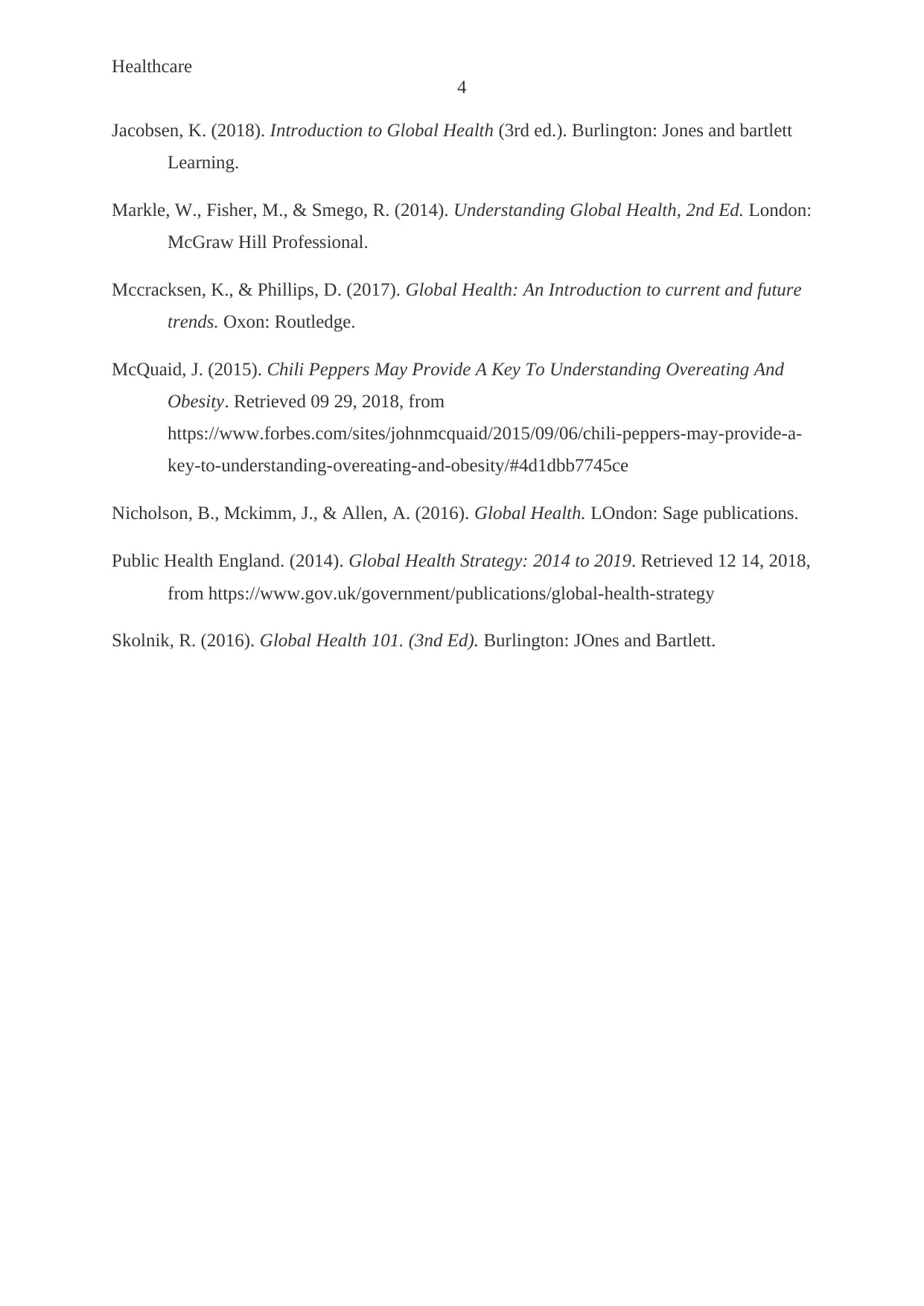
Healthcare
4
Jacobsen, K. (2018). Introduction to Global Health (3rd ed.). Burlington: Jones and bartlett
Learning.
Markle, W., Fisher, M., & Smego, R. (2014). Understanding Global Health, 2nd Ed. London:
McGraw Hill Professional.
Mccracksen, K., & Phillips, D. (2017). Global Health: An Introduction to current and future
trends. Oxon: Routledge.
McQuaid, J. (2015). Chili Peppers May Provide A Key To Understanding Overeating And
Obesity. Retrieved 09 29, 2018, from
https://www.forbes.com/sites/johnmcquaid/2015/09/06/chili-peppers-may-provide-a-
key-to-understanding-overeating-and-obesity/#4d1dbb7745ce
Nicholson, B., Mckimm, J., & Allen, A. (2016). Global Health. LOndon: Sage publications.
Public Health England. (2014). Global Health Strategy: 2014 to 2019. Retrieved 12 14, 2018,
from https://www.gov.uk/government/publications/global-health-strategy
Skolnik, R. (2016). Global Health 101. (3nd Ed). Burlington: JOnes and Bartlett.
4
Jacobsen, K. (2018). Introduction to Global Health (3rd ed.). Burlington: Jones and bartlett
Learning.
Markle, W., Fisher, M., & Smego, R. (2014). Understanding Global Health, 2nd Ed. London:
McGraw Hill Professional.
Mccracksen, K., & Phillips, D. (2017). Global Health: An Introduction to current and future
trends. Oxon: Routledge.
McQuaid, J. (2015). Chili Peppers May Provide A Key To Understanding Overeating And
Obesity. Retrieved 09 29, 2018, from
https://www.forbes.com/sites/johnmcquaid/2015/09/06/chili-peppers-may-provide-a-
key-to-understanding-overeating-and-obesity/#4d1dbb7745ce
Nicholson, B., Mckimm, J., & Allen, A. (2016). Global Health. LOndon: Sage publications.
Public Health England. (2014). Global Health Strategy: 2014 to 2019. Retrieved 12 14, 2018,
from https://www.gov.uk/government/publications/global-health-strategy
Skolnik, R. (2016). Global Health 101. (3nd Ed). Burlington: JOnes and Bartlett.
1 out of 5
Related Documents
Your All-in-One AI-Powered Toolkit for Academic Success.
+13062052269
info@desklib.com
Available 24*7 on WhatsApp / Email
![[object Object]](/_next/static/media/star-bottom.7253800d.svg)
Unlock your academic potential
Copyright © 2020–2025 A2Z Services. All Rights Reserved. Developed and managed by ZUCOL.




